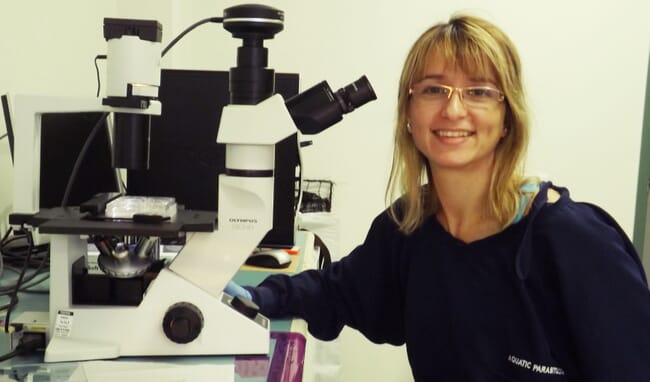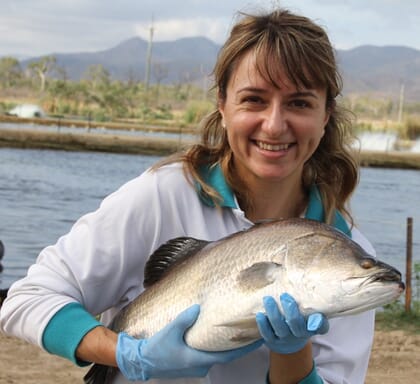Undertaken by Giana Bastos Gomes, a PhD candidate at the Centre for Sustainable Tropical Fisheries and Aquaculture at James Cook University in Australia, the project looked into the possibilities offered by using eDNA sampling to detect the presence of ciliate Chilodonella species in freshwater barramundi farms. Giana’s eDNA results indicated that high loads of the ciliate in the water preceded fish mortality events.
The findings have just been published in full in the journal Aquaculture, and here she explains the practical significance of her work to The Fish Site.
How much of a problem is Chilodonella and does it affect other fish species/geographies?
Chilodonella spp. are globally distributed ciliate parasites that affect most freshwater fish species. These parasites have been received considerable research attention over the last 10 years due to the increase of freshwater aquaculture production worldwide. The increased intensification of freshwater aquaculture systems has increased the risk of diseases such as chilodonellosis (infections caused by Chilodonella spp.).
How does environmental DNA (eDNA) sampling differ from traditional sampling procedures such as histopathology?
The use of eDNA for the detection of pathogens – such as bacteria and parasites – focuses on the detection and quantification of the target genetic material in water or sediment, for example, before animals get sick. So, we could call it a pre-emptive methodology, while traditional histopathology identifies the damage caused to tissue by pathogens when animals are already infected and are showing signs of disease.
Has it been widely used in aquaculture, or other livestock industries?
eDNA has mainly been used for forensics and conservation studies. It is a new approach for aquaculture, especially for commercial purposes, although it has been fairly widely used by researchers in recent times.

What’s the turnaround time between sampling and results?
It all depends on the distance between the farm and the laboratory. Once samples are in the lab it only takes a few days for the results of the genetic material amplification to be optimised. For a research project starting from scratch (such as mine) it takes a couple of years to develop the methodology, but in the near future, we want to deploy on-farm devices where results can be obtained in less than two hours.
On a practical level, how does the expense compare and how feasible is it to train fish farm operatives in its use?
The eDNA methodology has to be used as a preventive approach for disease outbreaks. Ideally, it should be used in conjunction with analysis of water quality parameters. Farmers will save money by not waiting until animals to get sick to take action. Just as for human health, in aquaculture prevention of diseases is cheaper than treatment.
The collection of water for eDNA is very simple and any farmer can do it. The more complicated and technical part of the work currently needs to be done in a molecular laboratory, but in the future with the use of on-farm detection devices, technicians in the field will be able to implement it. I’m also currently working on a DNA-based point-of-care device in a project funded by the Fisheries Research and Development Corporation (FRDC) and the Department of Agriculture and Water Resources to help farmers which are located in remote areas, far from diagnostic laboratories.

What drew you to the barramundi industry?
Barramundi are an iconic fish in Australia, and have attracted a lot of research, not only in this country but also in Asia. This fact and the close relationship I developed with important barramundi farms in Australia led me to find innovative solutions for diseases that affect this species.
Were you surprised by any of the results?
I was surprised that the technique worked so well for the detection of Chilodonella, as research is always gamble. You have an idea when you design your project but the results can be completely different compared to what you expected.
Did your research shed any light on what specific conditions favour Chilodonella outbreaks?
Our research demonstrated some trends between lower rainfall and high Chilodonella levels, which were especially virulent when fish were smaller. But further research using other fish hosts and more frequent sampling of water and water quality parameters in the future will be important to really determine the environmental drivers of Chilodonella outbreaks.
What implications do your results have for other aquaculture sectors?
The idea with this research was to use the eDNA methodology and water quality data from a freshwater fish farm as a model to prove the concept. Now this method can be used for other aquaculture industries.
How can farmers react to minimise the impacts of high parasite densities as discovered by the technique?
Each aquatic species and aquaculture system will have different approach but in the case of our study, farmers might consider changing the time of the year they stock their ponds with fish and may consider stocking ponds with larger fish. There may be chemical treatments which would be more effective applied before fish get sick and parasites spread further. More importantly eDNA can assist farm managers to improve their biosecurity protocols and strengthen their response capability.
How would you, or other researchers, be able to build on the results?
The possible applications for eDNA methodology in aquaculture are immense. For example, linking the quantification of pathogens (eDNA methodology) in aquaculture systems with real-time sensors to test water quality could be a game-changer for farmers. It could quickly demonstrate trends between pathogen build-up and drastic changes of oxygen or temperature, for example. Having rapid access to this kind of information will allow farmers to adopt the appropriate management strategies to minimise or avoid economic costs due to disease outbreaks.

Researcher profile
Giana Bastos Gomes is an aquaculture veterinarian researcher. Originally from Brazil, she migrated to Australia nine years ago. Giana’s career in aquaculture started in Brazil’s prawn in industry, but now she works with different aquaculture species with a focus on aquatic animal health. Giana is part of The Fish Vet Australia and is starting to work with portable pathogen detection devices and real-time environmental sensors to predict diseases risks in aquaculture.
Contact: giana.bastosgomes@my.jcu.edu.au or +61 413 616 988
LinkedIn: Giana Gomes
Twitter: @GianaBGomes



